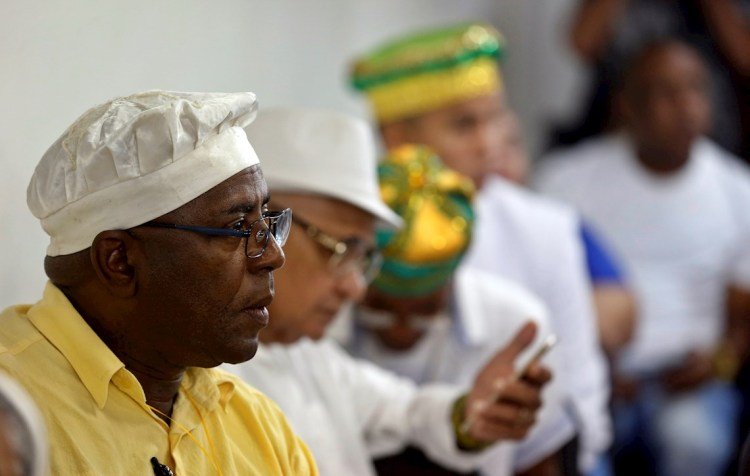Yoruba priests from Cuba agreed that the coronavirus pandemic affecting the world today was caused by ideological rivalry between the topmost political personalities worldwide. The priests came to this conclusion after studying the Ifá predictions in the Letter of the Year, released last January, for “a better understanding of events.”
“Ifá is pointing to this rivalry as the main cause of the origin of the pandemic that, in reality, is being established and spreading, fundamentally, at all the entrances and borders of a city,” says a post by the Yoruba Cultural Association of Cuba on Facebook, based on the reinterpretation of texts from its religious system.
“We cannot classify who is inclined to Good nor who is inclined to Evil since, Good and Evil, are two very relative concepts. In this contemporary world, everyone embraces the Ideology that they consider Good, while others consider it Evil,” explained the priests, for whom the spread of the pathogen may be due to conflicts between people with opposite positions.
“In this case, harmful medicinal preparations are used as an offensive weapon, causing certain ailments, very similar to those caused by the coronavirus,” they indicate.
https://www.facebook.com/asyorubacuba/posts/1292610244273482
The priests, grouped in the Yoruba Cultural Association and the Miguel Febles Padrón Organizing Commission, presented Ifá’s predictions for Cuba and the world, at the beginning of last January in a ceremony in which the awaited Letter of the Year was revealed.
According to the religious ritual, Oshún, the queen of fresh waters, fertility, femininity, love and great protector of the family, is the ruling deity, along with Obbatalá as an accompanying deity who defends peace and tranquility.
This Letter of the Year had already warned of an “increase in infectious contagious diseases caused by promiscuity” and the “proliferation of epidemics due to poor hygiene and social indiscipline.” However, after the expansion of COVID-19, the priests considered it necessary to reassess Ifa’s predictions for 2020 because, as they explain, “many consider that the arrival of this pandemic should have been warned.”
To do this, they again analyzed two narrations, one about “the discussion between Olófin and Èbita” and the other about “the rivalry between Òrúnmìlà and the Black Ram,” from which they extracted new interpretations, which refer to the “refusal of contrariety or sudden tragedy caused by the negative actions of our social environment or enemies,” the danger of the “increase in victims caused by the pandemic” and difficulties in performing funeral services.
They also comment on “the omission that many high-level personalities assume and not provide due support, abandoning the underprivileged to their fate” and narrate the negative action in one of the stories of the Bàbálú Ayé and Ògún orishas, recognized, respectively, as the owner of diseases and the God of Death, until they were finally dominated by Olófin.
“Both –Bàbálú Ayé and Ògún– originate a crisis accompanied by rivalries, disease and death, spiritual potentials that distinguish it,” explain the Yoruba priests, who interpret that the responsibility to overcome the disease, “in part, should rest with the professionals in the field of medical sciences, mainly in genetics, virology and biotechnology, sectors where new forms of microscopic life are created.” This, they say, “can be difficult as long as you do not have the support of the most powerful and the support of the leaders of the world, representatives of Olófin in the world.”
As a safeguard against disease, they recommend the Ebbó or ceremonies with offerings and sacrifices associated with what is interpreted in both narratives and suggest “certain medicinal plants that could be recommended to eradicate or, to a certain extent, remove the impact of the pandemic,” such as Calaguala –also known as Palm Fern– and Ginger, from which the Òrúnmìlà orisha had a healing tisane in the second narration.
According to the Babaláwo Juan Mesa (Fatumbí), Doctor in Theological Anthropology, “the Letter of the Year is the forecast model of events to occur in a life cycle of 365 days, according to the system of knowledge collected in Igbi bogbo fá, the sacred text of the religious system of Ifá.”
In his opinion, “the infallibility of the Letter depends on the correct interpretation of the odu that have come out in that ceremony. Regardless of the interpretations, the sacred document contains no possible mistake, hence the well-known phrase that ‘Orula is never wrong.’”
In this regard, the Yoruba Cultural Association of Cuba explains that its elaboration is “a very exhausting task, worthy of consideration by the majority of the followers. For these reasons we are not at liberty to ignore certain fundamental details that are expressed in the Ifá texts,” the reason now for their reinterpretation.
In the same way, he affirms that “much more could be said, after analyzing these two Ifá narrations. But the support of other analytical minds is essential, as they could contribute new ideas drawn from the enigmatic language of these myths.”
This divinatory rite has great significance in Cuba because many Cubans practice or know this religious system, and they follow the forecasts released by its priests every year.










